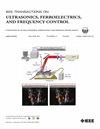基于自适应帧选择方法的体内超声动态冠状动脉血流成像。
IF 3.7
2区 工程技术
Q1 ACOUSTICS
IEEE transactions on ultrasonics, ferroelectrics, and frequency control
Pub Date : 2025-06-25
DOI:10.1109/TUFFC.2025.3582154
引用次数: 0
摘要
在商业超声心动图中使用超声进行冠状动脉成像仍然具有挑战性,因为冠状血管的小性质和心肌的复杂运动。几种超分辨率成像技术已应用于冠状动脉成像;然而,大多数只测量舒张期的冠状动脉血流,数据采集时间较长。为了解决这些问题,本研究提出了一种冠状动脉血管成像的自适应框架选择方法。在该方法中,使用绝对差和(SAD)算法选择心动周期内的相似帧,并且在不使用心电图门控数据的情况下计算冠状血管血流。实验通过高频超快超声成像在小鼠心脏进行。在多个心动周期(1 ~ 5个心动周期)中选取相似帧后,应用奇异值分解滤波器提取血流信号,获得动态冠状动脉图像,通过测量左冠状动脉和小动脉的多普勒超声图来证实图像的准确性。传统的方法(没有SAD),只计算舒张期的血流量,也进行了比较,以测量血管大小和信噪比。在最佳参数设置下,该方法的信噪比为20.74±1.62 dB。该方法在小动物模型中得到了成功的验证,具有应用于人类动态冠状动脉成像的潜力。本文章由计算机程序翻译,如有差异,请以英文原文为准。
In Vivo Ultrasound Dynamic Coronary Blood Flow Imaging Through Adaptive Frame Selection Method
Use of ultrasound for coronary imaging in commercial echocardiography remains challenging because of the small nature of coronary vasculature and the myocardium’s intricate motion. Several super-resolution imaging techniques have been applied for coronary imaging; however, most of them only measure the coronary flow during the diastolic phase and have a long data acquisition time. To address these problems, this study proposes an adaptive frame selection approach for coronary vasculature imaging. In this approach, similar frames within cardiac cycles are selected using the sum of absolute difference (SAD) algorithm, and the coronary vasculature blood flow is calculated without using electrocardiographic (ECG) gating data. Experiments were performed in mouse hearts through high-frequency ultrafast ultrasound imaging. After similar frames were selected from several cardiac cycles (one-five cycles), a singular value decomposition (SVD) filter was applied to extract blood flow signals and obtain a dynamic coronary vasculature image, the accuracy of which was confirmed by measuring Doppler sonograms from the left coronary artery (LCA) and arterioles. The conventional method (without SAD), in which only blood flow in the diastolic phase is calculated, was also conducted to enable a comparison in terms of measured vessel size and signal-to-noise ratio (SNR). The SNR for the proposed approach was found to be $20.74~\pm ~1.62$ dB, under the best parameter settings. The proposed approach was successfully verified in the small animal model and has potential for use in human dynamic coronary artery imaging.
求助全文
通过发布文献求助,成功后即可免费获取论文全文。
去求助
来源期刊
CiteScore
7.70
自引率
16.70%
发文量
583
审稿时长
4.5 months
期刊介绍:
IEEE Transactions on Ultrasonics, Ferroelectrics and Frequency Control includes the theory, technology, materials, and applications relating to: (1) the generation, transmission, and detection of ultrasonic waves and related phenomena; (2) medical ultrasound, including hyperthermia, bioeffects, tissue characterization and imaging; (3) ferroelectric, piezoelectric, and piezomagnetic materials, including crystals, polycrystalline solids, films, polymers, and composites; (4) frequency control, timing and time distribution, including crystal oscillators and other means of classical frequency control, and atomic, molecular and laser frequency control standards. Areas of interest range from fundamental studies to the design and/or applications of devices and systems.

 求助内容:
求助内容: 应助结果提醒方式:
应助结果提醒方式:


